Do you feel disconnected with your team members?
Are you unable to visualize all of the ongoing projects status?
Do you feel your message is not conveyed properly to your team?
Don’t worry! I have also been through this situation at a time. I was totally detached from my team & work was disorganized. When I examined the source of the problem, I discovered that my internal communication strategy was diverging. I discovered the flaws, worked on them, and now can say that we at ProofHub work as a connected & transparent team.
Understanding the value of internal communications and how challenging it is to foster them in the system, I would like to share the practices and techniques that I have employed with you all. Let’s look at how to create an effective strategy for improving internal communications, and how this will boost your team’s productivity and employee’s performance.
Take a look at how to build effective strategic internal communication in 5 ways with ProofHub.
Importance of Internal communication strategy
“90% of all management problems are caused by miscommunication.” Dale Carnegie
Whether it is about missed deadlines, cross-functional teams confusion related to work progress, or assuming wrong business goals, all are the result of miscommunication within the team.
When you are not able to deliver the right information to your team, they are not able to connect with you and each other, roles and responsibilities are not clear, and you will only get project delays, low-quality work, and burnout.
Strategic internal communication will help in:
- Convey the right message to the right people at the right time.
- Open communication regarding project scope, roles, and accountabilities; hence, hence no conflicts or confusions.
- Encourages employees to work more enthusiastically and in sync.
- Employees can come up with new ideas freely and improve the company’s productivity.
- Build trust and bring transparency among team members; this, in turn, improves employee retention.
- Better the workload, hence low burnout, and this improves employees’ mental wellbeing and fosters a positive company culture.
- It is fun to work at the office; even big projects seem like small tasks when you are conveying the right direction and teams are working together.
Better internal communication promotes teamwork, improves team performance, promotes happier work environments, resulting in organized work & complete work satisfaction.
There is a far-reaching strategy that we worked on, and I feel delighted if these can work for you as well in building effective internal communication with your team, working unhindered, and collaborating seamlessly. So, without further delay, let’s discuss how we can create a positive work culture by fostering better internal communications.
Before we begin, let us motivate and inspire the team for positive change. Keep motivating your team with these teamwork quotes. Stay inspired and motivated!
6 Effective strategies for managers to build effective internal communication
We are about to make a big change and plan to bring effective communication, but the question is, where to start?
Every organization operates on a system; whether you use multiple tools to communicate or another method to manage the team, it can be difficult to implement a new strategy and ensure that all employees will work in that new manner.
But it’s not impossible. You can start putting this transformation into action by being clear about what you expect from your team and communicating honestly with them. Start making adjustments in small steps, such as altering meeting schedules, centralizing one method of communication, separating casual from formal conversations, and so forth.

1. Set up a standardized way to communicate
The very basic intent of communication is to deliver the right information to the right person. But what if you are failing in doing so?
This simple intent can be easily lost while managing large teams. The reason behind this is passive collaboration with teams and using multiple tools to collaborate.
Multiple emails
Opened the emails and got trapped in the flood of emails. There are many emails that are just promotional, and it is sometimes hard to find which emails actually require attention.
Further, if you are logged out or have not opted out of receiving notifications, there are 100 percent chances that you can miss the important details.
This isn’t just an issue with emails nowadays.
According to some recent research done by Egress, “95% of IT leaders believe sensitive client and corporate data is at risk of loss and unauthorized disclosure via email.”
Multiple apps for communication
Secondly, using multiple apps for different communications creates a lot of chaos and causes a loss of precious time and work efficiency.
For instance, multiple modes of communication, like emails for formal conversations, Slack or Google Meetups for project discussions, and any other mode to share files or creative assets, hold the employees to actual work.
So, the very first step in building an effective internal communication strategy is to standardize your flow of information with your team members.
Solution
- The best solution is to use a task management platform where you can assign one task to multiple team members, attach every detail, and comment on related task queries all in one place. This eliminates the need to send emails to discuss, ask questions, or make changes to a task because you can do everything in one place.
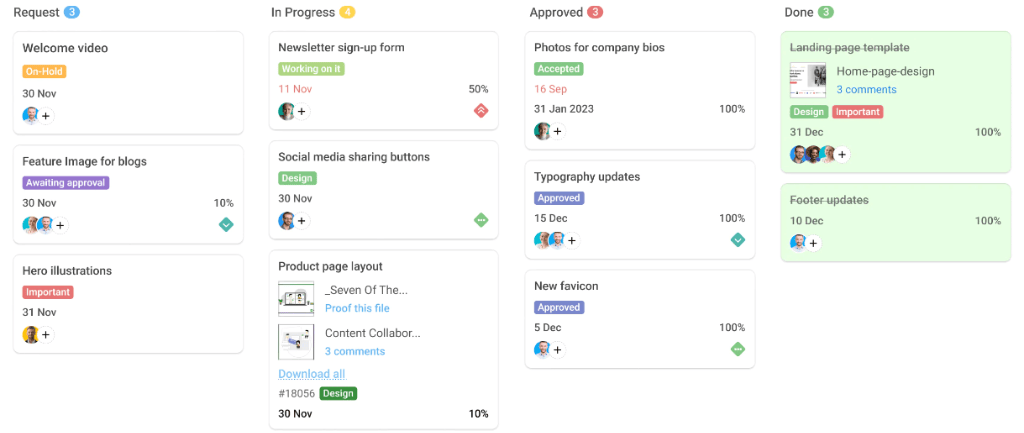
2. Foster a positive communication hierarchy
While talking about strategic internal communication, we can’t skip hierarchy communication. As a leader and communication professional, it is crucial that you communicate timely to deliver the right information to the right employees to avoid overlaps or loopholes. It enables your staff to focus more on your task rather than wasting time reading messages or discussing ideas, even when it is unnecessary or outside the scope of their duties.
To keep information to those who actually want to know it and save others’ time, we should improve our hierarchical communication. Let’s take a look and see if these can be helpful for you:
Daily meeting time
On one hand, meetings are essential to keep an update on daily work, but on the other, they can be problematic as well. The idea is good, but what matters is how we execute it.
Arrange meetings, but keep a record of each one. Use a calendar to schedule meetings on a daily, weekly, or monthly basis. Set an event to recur and share it with your coworkers. The main thing to remember here is to avoid scheduling extra meetings in between those times. If you really want, inform your team members in advance.

Other than this, I would also recommend using meetings for only:
- Daily, weekly, or monthly work updates
- Employee trainings
- Essential official announcements
Make sure you are setting a time for such meetings so that your colleagues can arrange their time and work accordingly to maintain their pace.
Formal discussions
It is very important to keep formal conversation to only specific channels. For instance, if your teammates have a project-related query and are sharing important ideas, files, or notes, you can create a different discussion section for each project that only includes the teammates who are part of it.
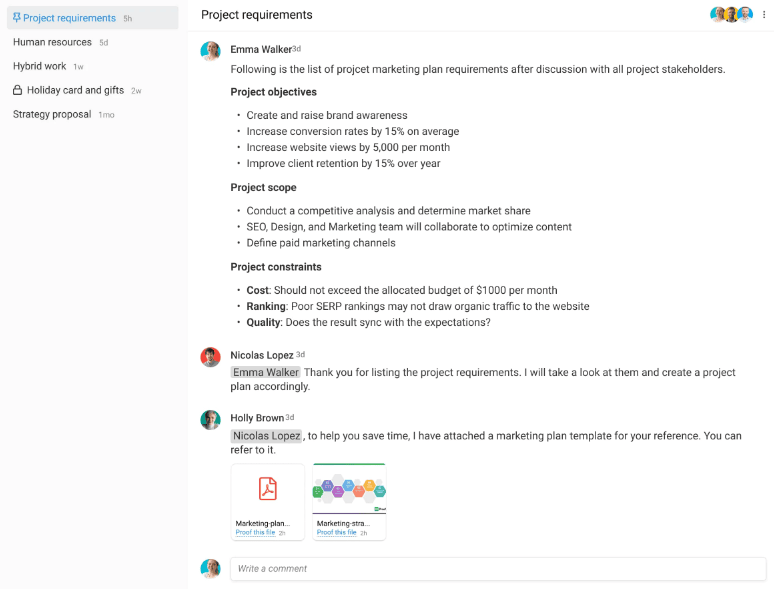
Create formal project discussions seamlessly & reduce the work chaos with ProofHub.
One-to one or group chat
The next type of hierarchical communication that also needs to be taken care of is lateral communication. I can denote it as a one-on-one chat or group conversation, as it occurs mostly among team members of the same team or cross-functional teams, where they might need to discuss a task or project.
In such times, it is totally a waste of time if we have to create a whole discussion thread or hold an official meeting for it.
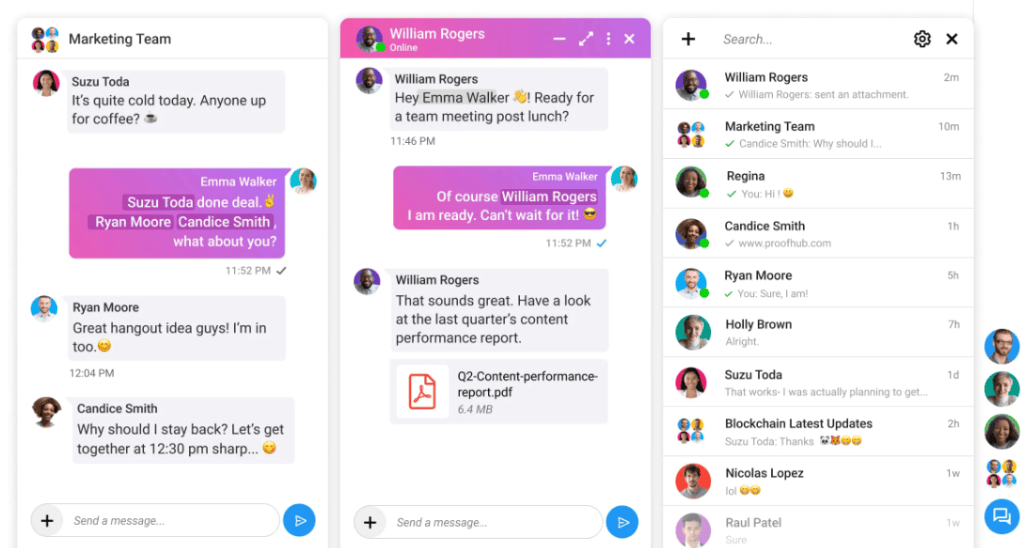
Official announcements
When it comes to official announcements, appreciations for job performance, and explaining new rules and regulations, the best thing that works is to publish these announcements on teams’ timelines, so that everyone can see the information at the same time without hampering their work.
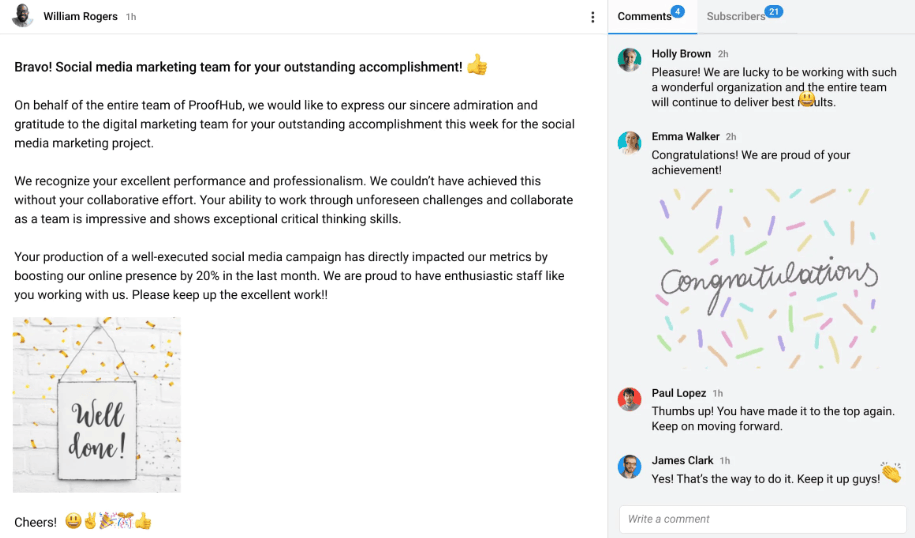
Now celebrate all project victories, job appreciations and your teammates work anniversaries together with announcements.
3. Keep transparency while working
Your entire team will work better and with greater enthusiasm if they know what your mission statement is and what exactly their work entails. Work transparency is a very essential internal communication factor to improve employee satisfaction and employee retention. We feel the following three elements are must-haves to foster a transparent work culture:
Track project progress in real-time
The very first step to creating a transparent culture is to provide your employees with complete visibility of project scope, which projects are ongoing, and how their work is dependent on that of other employees. Choose a platform, where each employee can look at what tasks are in process, at what stage they are, so that they can do their work accordingly. This way, they know how important their work is and at what time they need to accomplish it.
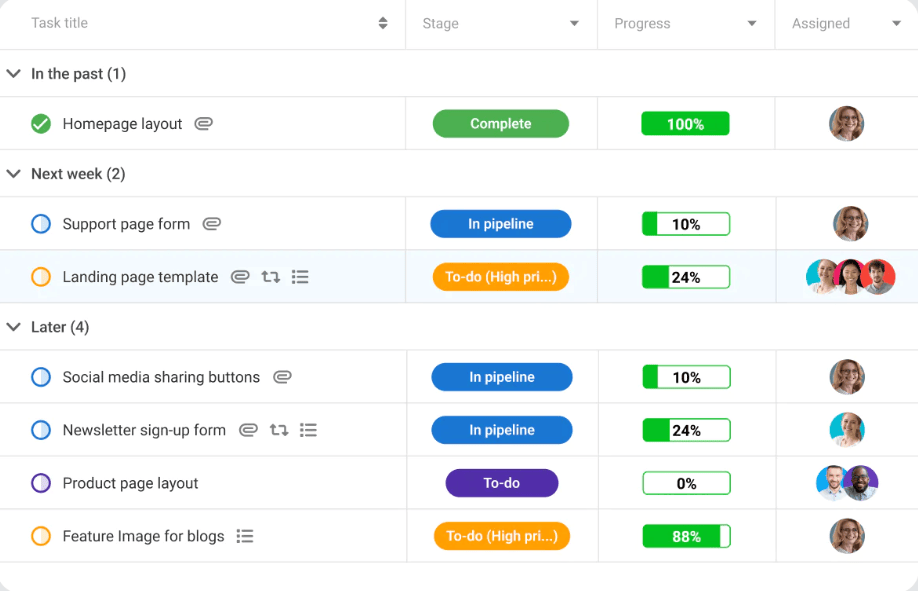
Sharing information
Another step that builds trust with your employees is sharing internal information with them at the right time.
Undoubtedly, organize discussions or instant conversations are considered an important part of sharing information, but another point that you might forget is sharing notes.
A single place for sharing ideas, writing down important details, keeping important links, and creating PDFs will help team members work together. This can save them time in researching and also allow them to work at a fast pace if ideas and details are clear and shared.
Let’s know further 7 practices to promote internal knowledge sharing at your company.
Held “let’s talk” sessions
The “let’s talk” session is a great way to build a transparent relationship and trust with your team members. The employees who are not able to share their views or are hesitant to ask something in group discussions or video calls can clearly open up in one-on-one sessions.
Make your one-to-one conversations more interactive & productive. Take a look at how you can excel in it.
4. Collaborate and set clear expectations
As a manager, it is your responsibility to deliver clear expectations to your team members. This not only helps them to work in a direction but also prevents rework and confusion related to the scope of the work.
Define goals and queries to ask in the meeting
Definitely, you will benefit from a meeting or discussion before initiating a new project. Else, you’ll have regular daily meetings for sure.
Make sure your goal is defined and clear before doing any meetings. Try to implement SMART goals practices to define your objectives.
This will help you to structure your meetup goal, prioritize important tasks, and you are better able to track on-going project progress.
This is not only helpful for you but also for your teammates, as they will know what they need to do for the whole day, which tasks are important, and how much time they have to do them. They can work with more focus when the goals are clear in their minds.
Are you still confused about how to define better goals? Let’s have a step-by-step guide to effective objectives and key results.
Keep formal & informal discussions apart
While both formal and informal meetings aim to foster discussion and information sharing, they are not the same.
- Informal meetings are more relaxed, whereas formal meetings involve a clear agenda.
- Informal meetings require less documentation, whereas formal meetings often involve time boundation.
- Formal meetings usually have more organizational decisions making conversations, whereas informal meetings do not usually necessitate an official vote on actions.
So, clarify in advance, whether the meetings or discussions are formal or informal so that your team members can prepare themselves accordingly.
Set clear goals in meetings and engage your team members effectively with these 5 tips to run most effective team meetings.
5. Encourage feedback
Without good feedback, the internal communication strategy is incomplete.
If you want employees to understand the goal of what is being “communicated,” you must first explain “why” and also pay attention to their views on it. Only then can you determine whether the message was correctly understood.
Internal communication that focuses on feedback ensures that everyone understands the message.
Make sure to follow these 3 steps for better feedback at work:
Foster a culture of information sharing
Work environments that encourage employees to work together in a more collaborative way foster the culture of information sharing by:
- Find a shared communication platform for sharing information.
- Encourage an “open door policy” so that employees can be more open about their creative ideas.
- Reward employees who come forward and share their inputs to improve work productivity.
- Create an environment where mistakes are not a big deal and hinder the employee’s performance.
Must give positive feedback
It’s essential to provide feedback, but how to do so is equally important. You need to give your opinions to your employees in a way that they won’t take them as criticism.
- The very first thing is to give feedback on time. Employees grab it more effectively when it is fresh.
- Give employees constructive feedback, talk about their work not about them.
- Must advise employees how they can do better in their work and, if possible, give them examples too.
- It is also essential to give employees positive feedback along with their low points.
- Be sincere while giving feedback; if your tone doesn’t match your views, your employees might not take it seriously.
Encourage teamwork
“Teamwork” is not only a word; it is the fuel that is required to make a business successful. Does your organization really work together in a positive way? Let’s take a look at how we can build a culture of teamwork:
- The very first thing you can do is organize team-building activities and also hold team lunches from time to time so that your team feels more connected.
- While building a team, focus on building a diverse workplace that includes different minds so that you can have diverse ideas on the table.
- As we discussed above as well, it is crucial to maintain clarity in the work accountabilities and in assigning tasks to avoid any overlap and confusion in the project outcome.
- Let your team decide what is best for them and how they can better collaborate with the team.
- Also, don’t forget to find a shared platform for team collaboration so that you can keep all the team members in the loop.
6. Choose the right communication tools
You actually need the right communication tool to build a strategic internal communication where there is a transparent work culture, teams collaborate better, and deadlines are met.
There are numerous communication tools available online, but determining which one best suits your team is critical.
So, while looking for a communication tool, keep the following points in mind:
Do internal communication audit
This audit is necessary to know who effectively is engaged and collaborating with each other. If you are designing an internal communication strategy, then internal communication audit is the core component of this.
It helps you to better understand your employees communications goals, explote where the present communication tools are solving the required intent and help you to know what your employees review on this topic.
In an audit, you can ask your employees a few questions, like:
- Do employees often get confused and don’t get clear messages while using the present communication tools?
- Are our internal communications able to convey transparency?
- Are the present communication modes visually dynamic?
- Are we able to create employee-centric communications?
- Do we have the right communication modes to connect?
Ask these questions to your teammates and find out what improvements are required.
How to find right communication tool
This audit is necessary to know who is effectively engaged and collaborating with each other. If you are designing an internal communication strategy, then internal communication audit is the core component of this.
It helps you to better understand your employees communications goals, explote where the present communication tools are solving the required intent and help you to know what your employees review on this topic.
In an audit, you can ask your employees a few questions, like:
- Do employees often get confused and don’t get clear messages while using the present communication tools?
- Are our internal communications able to convey transparency?
- Are the present communication modes visually dynamic?
- Are we able to create employee-centric communications?
- Do we have the right communication modes to connect?
Ask these questions to your teammates and find out what improvements are required.
Take a look at “18 amazing communication tools for businesses in 2024” & find which collaboration tool works for you the best.
Conclusion
All these above-mentioned points can really help you create an effective internal communication strategy for your teammates, and you will be able to find what works best for your team to work together efficiently.
For years, we have been using ProofHub to collaborate and communicate with one another. Whether it’s visually exploring each project or instantly collaborating with a team member, we’re doing it skillfully with ProofHub.
Take a look through a video “How ProofHub works?”
FAQs:
What are internal communication strategic objectives?
The main objective of strategic internal communication is to create a collaborative, engaging, and real-time culture of working, where every teammate is able to work for better team performance.
What are the four types of internal communication?
The four main types of internal communications are leadership, peer-to-peer, management-to-employee, and employee-up communications. These types of meetings help to create a better flow of information within the organization.
What are the pillars of internal communication?
The 3 basic pillars of internal communication are: Listen, Engage and Connect. It is important to listen to your employees, engage them to work together, and connect them in real-time.
What are roles of strategic internal communication?
The role of strategic internal communication is to reduce confusion among employees, improve employee engagement, employee behavior, build trust, and improve overall team productivity.

